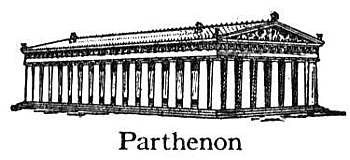Last Updated on 31 July 2008

The Parthenon is the famous monument that sits atop a large rock hill called the Acropolis in Athens, Greece. It was build over 2,500 years ago, dedicated to the goddess Athena. And it is amazing.
Over the centuries the structure was used as a temple, cathedral, mosque, government headquarters and even a munitions warehouse.
The original structure of the Parthenon stayed intact for around 2,000 years, until as a storehouse for gunpowder, it was blown up by a stray cannonball during a war in 1687. While nature has affected the structure, most of the damage has been caused by humans (e.g. stray cannonballs, pollution from cars). More damage was done to the Parthenon in that year than in it’s 2,500 history.
Over the centuries, there have been several waves of conservation and restoration of the Parthenon and surrounding monuments. As time and technology have improved, the tools, methods, and accuracy have improved as well.
In the 19th century, restoration efforts – using the best technology of the day – included replacing missing marble pieces with poured cement fillings, and securing the structure with iron clamps. The cement has chipped. The rods rusted, expanded, and caused additional cracks to the marble.

Men placing a section of the epistyle (beam) and frieze into place
[click for larger image]
Today, they are replacing the missing marble with new marble from the very quarry used in the original construction. And to hold pieces together, non-corrosive titanium rods.

The white pieces are the newly quarried marble cut to the original dimensions of the Parthenon, and precisely connected to the original piece.
The columns were built by stacking huge pieces of marble. Contemporary technology revealed that – even though the columns looked proper – they were re-constructed wrong. Parts of the first column were stacked in the second and third. Parts of the second column, in the first and fifth, etc.

For illustration purposes only, I’ve shown the
missed-matched column pieces
Re-construction teams had to take apart the former construction and re-assemble the columns properly. Wow.
The Parthenon inspires. Makes me wonder what 20th or 21st Century construction will exist in the year 4,500?
What at your business is stacked wrong? And, although it may appear to be proper, really should be re-stacked properly?
Parthenon Fun Fact: Did you know most of the straight lines on the Parthenon are actually curved?

Being such an immense structure it had to be constructed with optical corrections. Straight lines – at that scale – would make the building look like it was sagging, as exaggerated in the illustration below.

So the designers compensated by adding curves as seen (exaggerated) below.

Source: Optical correction images from VisualIllusion.net
